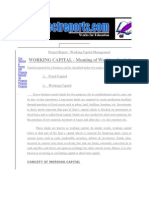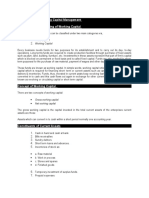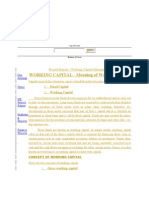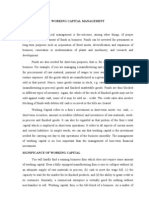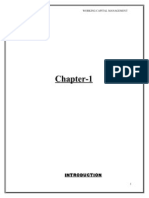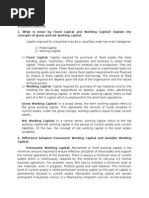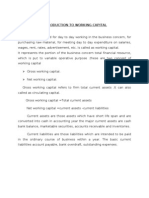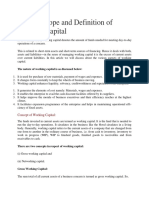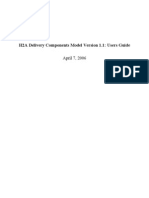WORKING CAPITAL - Meaning of Working Capital
Uploaded by
Priyanka AjayWORKING CAPITAL - Meaning of Working Capital
Uploaded by
Priyanka AjayProject Report - Working Capital Management WORKING CAPITAL - Meaning of Working Capital Capital required for a business can
be classified under two main categories via, 1) 2) Fixed Capital Working Capital
Every business needs funds for two purposes for its establishment and to carry out its day- to-day operations. Long terms funds are required to create production facilities through purchase of fixed assets such as p&m, land, building, furniture, etc. Investments in these assets represent that part of firms capital which is blocked on permanent or fixed basis and is called fixed capital. Funds are also needed for short-term purposes for the purchase of raw material, payment of wages and other day to- day expenses etc. These funds are known as working capital. In simple words, working capital refers to that part of the firms capital which is required for financing short- term or current assets such as cash, marketable securities, debtors & inventories. Funds, thus, invested in current assts keep revolving fast and are being constantly converted in to cash and this cash flows out again in exchange for other current assets. Hence, it is also known as revolving or circulating capital or short term capital. CONCEPT OF WORKING CAPITAL There are two concepts of working capital: 1. 2. Gross working capital Net working capital
The gross working capital is the capital invested in the total current assets of the enterprises current assets are those Assets which can convert in to cash within a short period normally one accounting year.
CONSTITUENTS OF CURRENT ASSETS 1) 2) 3) 4) 5) Cash in hand and cash at bank Bills receivables Sundry debtors Short term loans and advances. Inventories of stock as: a. b. c. d. Raw material Work in process Stores and spares Finished goods
6. Temporary investment of surplus funds. 7. Prepaid expenses 8. Accrued incomes. 9. Marketable securities.
In a narrow sense, the term working capital refers to the net working. Net working capital is the excess of current assets over current liability, or, say: NET WORKING CAPITAL = CURRENT ASSETS CURRENT LIABILITIES. Net working capital can be positive or negative. When the current assets exceeds the current liabilities are more than the current assets. Current liabilities are those liabilities, which are intended to be paid in the ordinary
course of business within a short period of normally one accounting year out of the current assts or the income business. CONSTITUENTS OF CURRENT LIABILITIES 1. 2. 3. 4. 5. 6. 7. Accrued or outstanding expenses. Short term loans, advances and deposits. Dividends payable. Bank overdraft. Provision for taxation , if it does not amt. to app. Of profit. Bills payable. Sundry creditors.
The gross working capital concept is financial or going concern concept whereas net working capital is an accounting concept of working capital. Both the concepts have their own merits. The gross concept is sometimes preferred to the concept of working capital for the following reasons: 1. It enables the enterprise to provide correct amount of working capital at correct time. Every management is more interested in total current assets with which it has to operate then the source from where it is made available. It take into consideration of the fact every increase in the funds of the enterprise would increase its working capital. This concept is also useful in determining the rate of return on investments in working capital. The net working capital concept, however, is also important for following reasons:
2.
3.
4.
It is qualitative concept, which indicates the firms ability to meet to its operating expenses and short-term liabilities. IT indicates the margin of protection available to the short term creditors. It is an indicator of the financial soundness of enterprises. It suggests the need of financing a part of working capital requirement out of the permanent sources of funds.
CLASSIFICATION OF WORKING CAPITAL Working capital may be classified in to ways: o o On the basis of concept. On the basis of time.
On the basis of concept working capital can be classified as gross working capital and net working capital. On the basis of time, working capital may be classified as: Permanent or fixed working capital. Temporary or variable working capital
PERMANENT OR FIXED WORKING CAPITAL Permanent or fixed working capital is minimum amount which is required to ensure effective utilization of fixed facilities and for maintaining the circulation of current assets. Every firm has to maintain a minimum level of raw material, work- inprocess, finished goods and cash balance. This minimum level of current assts is called permanent or fixed working capital as this part of working is permanently blocked in current assets. As the business grow the requirements of working capital also increases due to increase in current assets. TEMPORARY OR VARIABLE WORKING CAPITAL Temporary or variable working capital is the amount of working capital which is required to meet the seasonal demands and some special exigencies. Variable working capital can further be classified as seasonal working capital and special working capital. The capital required to meet the seasonal need of the enterprise is called seasonal working capital. Special working capital is that part of working capital which is required to meet special exigencies such as launching of extensive marketing for conducting research, etc.
Temporary working capital differs from permanent working capital in the sense that is required for short periods and cannot be permanently employed gainfully in the business. IMPORTANCE OR ADVANTAGE OF ADEQUATE WORKING CAPITAL SOLVENCY OF THE BUSINESS: Adequate working capital helps in maintaining the solvency of the business by providing uninterrupted of production. Goodwill: Sufficient amount of working capital enables a firm to make prompt payments and makes and maintain the goodwill. Easy loans: Adequate working capital leads to high solvency and credit standing can arrange loans from banks and other on easy and favorable terms. Cash Discounts: Adequate working capital also enables a concern to avail cash discounts on the purchases and hence reduces cost. Regular Supply of Raw Material: Sufficient working capital ensures regular supply of raw material and continuous production. Regular Payment Of Salaries, Wages And Other Day TO Day Commitments: It leads to the satisfaction of the employees and raises the morale of its employees, increases their efficiency, reduces wastage and costs and enhances production and profits. Exploitation Of Favorable Market Conditions: If a firm is having adequate working capital then it can exploit the favorable market conditions such as purchasing its requirements in bulk when the prices are lower and holdings its inventories for higher prices. Ability To Face Crises: A concern can face the situation during the depression.
Quick And Regular Return On Investments: Sufficient working capital enables a concern to pay quick and regular of dividends to its investors and gains confidence of the investors and can raise more funds in future. High Morale: Adequate working capital brings an environment of securities, confidence, high morale which results in overall efficiency in a business.
EXCESS OR INADEQUATE WORKING CAPITAL Every business concern should have adequate amount of working capital to run its business operations. It should have neither redundant or excess working capital nor inadequate nor shortages of working capital. Both excess as well as short working capital positions are bad for any business. However, it is the inadequate working capital which is more dangerous from the point of view of the firm. DISADVANTAGES OF WORKING CAPITAL 1. REDUNDANT OR EXCESSIVE
Excessive working capital means ideal funds which earn no profit for the firm and business cannot earn the required rate of return on its investments. Redundant working capital leads to unnecessary purchasing and accumulation of inventories. Excessive working capital implies excessive debtors and defective credit policy which causes higher incidence of bad debts. It may reduce the overall efficiency of the business. If a firm is having excessive working capital then the relations with banks and other financial institution may not be maintained. Due to lower rate of return n investments, the values of shares may also fall.
2.
3.
4. 5.
6.
7.
The redundant working capital gives rise to speculative transactions
DISADVANTAGES OF INADEQUATE WORKING CAPITAL Every business needs some amounts of working capital. The need for working capital arises due to the time gap between production and realization of cash from sales. There is an operating cycle involved in sales and realization of cash. There are time gaps in purchase of raw material and production; production and sales; and realization of cash. Thus working capital is needed for the following purposes: For the purpose of raw material, components and spares. To pay wages and salaries To incur day-to-day expenses and overload costs such as office expenses. To meet the selling costs as packing, advertising, etc. To provide credit facilities to the customer. To maintain the inventories of the raw material, work-in-progress, stores and spares and finished stock.
For studying the need of working capital in a business, one has to study the business under varying circumstances such as a new concern requires a lot of funds to meet its initial requirements such as promotion and formation etc. These expenses are called preliminary expenses and are capitalized. The amount needed for working capital depends upon the size of the company and ambitions of its promoters. Greater the size of the business unit, generally larger will be the requirements of the working capital. The requirement of the working capital goes on increasing with the growth and expensing of the business till it gains maturity. At maturity the amount of working capital required is called normal working capital. There are others factors also influence the need of working capital in a business.
FACTORS DETERMINING REQUIREMENTS
THE
WORKING
CAPITAL
1. NATURE OF BUSINESS: The requirements of working is very limited in public utility undertakings such as electricity, water supply and railways because they offer cash sale only and supply services not products, and no funds are tied up in inventories and receivables. On the other hand the trading and financial firms requires less investment in fixed assets but have to invest large amt. of working capital along with fixed investments. 2. SIZE OF THE BUSINESS: Greater the size of the business, greater is the requirement of working capital. 3. PRODUCTION POLICY: If the policy is to keep production steady by accumulating inventories it will require higher working capital. 4. LENTH OF PRDUCTION CYCLE: The longer the manufacturing time the raw material and other supplies have to be carried for a longer in the process with progressive increment of labor and service costs before the final product is obtained. So working capital is directly proportional to the length of the manufacturing process. 5. SEASONALS VARIATIONS: Generally, during the busy season, a firm requires larger working capital than in slack season. 6. WORKING CAPITAL CYCLE: The speed with which the working cycle completes one cycle determines the requirements of working capital. Longer the cycle larger is the requirement of working capital.
DEBTORS CASH FINISHED GOODS
RAW MATERIAL
WORK IN PROGRESS
7.
RATE OF STOCK TURNOVER: There is an inverse corelationship between the question of working capital and the velocity or speed with which the sales are affected. A firm having a high rate of stock turnover wuill needs lower amt. of working capital as compared to a firm having a low rate of turnover. CREDIT POLICY: A concern that purchases its requirements on credit and sales its product / services on cash requires lesser amt. of working capital and vice-versa. BUSINESS CYCLE: In period of boom, when the business is prosperous, there is need for larger amt. of working capital due to rise in sales, rise in prices, optimistic expansion of business, etc. On the contrary in time of depression, the business contracts, sales decline, difficulties are faced in collection from debtor and the firm may have a large amt. of working capital.
8.
9.
10. RATE OF GROWTH OF BUSINESS: In faster growing concern, we shall require large amt. of working capital. 11. EARNING CAPACITY AND DIVIDEND POLICY: Some firms have more earning capacity than other due to quality of their products, monopoly conditions, etc. Such firms may generate cash profits from operations and contribute to their working capital. The dividend policy also affects the requirement of working capital. A firm maintaining a steady high rate of cash dividend irrespective of its profits needs working capital than the firm that retains larger part of its profits and does not pay so high rate of cash dividend. 12. PRICE LEVEL CHANGES: Changes in the price level also affect the working capital requirements. Generally rise in prices leads to increase in working capital.
Others FACTORS: These are: Operating efficiency. Management ability. Irregularities of supply. Import policy. Asset structure. Importance of labor. Banking facilities, etc.
MANAGEMENT OF WORKING CAPITAL Management of working capital is concerned with the problem that arises in attempting to manage the current assets, current liabilities. The basic goal of working capital management is to manage the current assets and current liabilities of a firm in such a way that a satisfactory level of working capital is maintained, i.e. it is neither adequate nor excessive as both the situations are bad for any firm. There should be no shortage of funds and also no working capital should be ideal. WORKING CAPITAL MANAGEMENT POLICES of a firm has a great on its probability, liquidity and structural health of the organization. So working capital management is three dimensional in nature as 1. It concerned with the formulation of policies with regard to profitability, liquidity and risk. It is concerned with the decision about the composition and level of current assets.
2.
3.
It is concerned with the decision about the composition and level of current liabilities.
Scribd Upload a Document Search Documents Explore Sign Up | Log In Limitation: The study period of 45 days as prescribed by Kakatiya university. The study is limited up to the date and information provided by kesoram cementand is annual reports. The report will not provide exact fixed assets status a n d p o s i t i o n i n K e s o r a m cement. Itmay varying from time to time and situation to situation. This report is not helpful in investing in kesoram cement industries either thoughdisinvestments or capital market. The accounting procedure and other accounting princi p l e s a r e l i m i t e d b y t h e company changes fixed assets performance. Sources of data : The data gathering method is adopted purely from secondary sources. The theoretical contents are gathered from eminent t e x t s b o o k s r e f e r e n c e a n d library at Kesoram cement industries.
The financial data and information is gathered from annual reports of the companyinternal records. Interpretation, conclusion and suggestion are purely b a s e o n m y o p i n i o n a n d suggestions provided by the project guide. 9
Chapter-II INDUSTRY PROFILE 10 INDUSTRY PROFILE The 85 year old Indian cement industry is one o f t h e c a r d i n a l a n d b a s i c infrastructure industries, which enjoys core sector status and play a crucial role in thee c o n o m i c d e v e l o p m e n t a n d g r o w t h o f a c o u n t r y . B e i n g a c o r e s e c t o r i s i n d u s t r y w a s subject to price and or distribution controls almost uninterruptedly from world war -II to1 9 8 2 . W h e n t h e g o v e r n m e n t o f I n d i a a n n o u n c e d t h e p a r t i a l d e c o n t r o l m a n u f a c t u r i n g cement became increasingly attractive industry and the industry experienced substantialexpansion.As the supply in response to the 1982 partial decontrol was significant in march,1989. Price and distribution control were finally dispensed with. It was one of the firstmajor industries in the country to be so deregulated. DEFINATION OF CEMENT Cement may be defined as it is a mixture of calcium silicate and aluminates whichhave the property of setting and hardening under water. The amount of silica, alumna whoi s p r e s e n t i n each crust is sufficient to combine with calcium oxide [ c a o ] t o f r o m t h e corresponding calcium silicate and aluminates. 11 CLASSIFICATION OF CEMENT Cement is 3 typesi. Puzzolantic cementii. Natural cementiii. Portland cement
1. Puzzolantic cement: It consists of silicates calcium and aluminum. It shows the hydraulic, propertieswhen it is in the form of powder and being mixed with suitable proportion of lime. Therate of hardening is much slower and the comprehensive strength developed is about a half of Portland cement. It us found more resistant to the chemical action that others. 2. Natural cement: This is natural occurring material. It is obtained form cement rocks. The cementr o c k s a r e c l a y i n g l i m e s t o n e s c o n t a i n i n g s i l i c a t e s a l u m i n a t e s o f c a l c i u m . T h e s e l l i n g property of this cement is more than the Portland cement but is comprehensive strength ishalf of its. 12
3. Portland cement: a) Ordinary Portland cementb) Rapid hardening Portla nd cementc ) L o w h e a t c e m e n t d) White or colored cemente) Water proof Portland cementf ) P o r t l a n d s l a g c e m e n t g ) P o r t l a n d p u z z o h) Sulphate resisting c ementi ) O i l w e l l c e m e n t INDIAN CEMENT 1NDUSTERY - PRESENT STATUS After the deli censing of the industry in July, 1991 it reacted positively to the policyc h a n g e s . N e w c a p a c i t i e s c r e a t e d and the volume of the production increased. From a situation of importing cement, the country started exporting due to high quality and costeffectiveness. After liberalization the black market in cement also disappearedCurrently INDIA stands second largest in the cement production world wide after c h i n a a f t e r I n d i a , j a p a n s a n d U S A s t a n d s . O n t h e o t h e r h a n d I n d i a ' s p e r c a p i t a l consumpti on is only 100kgs. As compared to the world average of 260kgs. The industryhas 59 companies owing 115 plants.In the mailer of exports, the government considers cement as extreme focuses are&However Indian cement in the global market is not very competitive due to high power and full costs. In order to improve its position in the international
market. Technologicalup gradation is essential in terms of process up process up gradation productdiversification costs reduction quality control and energy savings 13
of 60 Leave a Comment You must be logged in to leave a comment. Submit Characters: 400 Chapter-III COMPANY PROFILE for Project Download or Print 1,140 Reads Info and Rating
Uploaded by Chanty Sridhar Follow Download
Search TIP Press Ctrl-F to quickly search anywhere in the document. Sections Chapter-II Chapter-III COMPANY PROFILE Chapter-IV Chapter-V Chapter-VI More from This User Related Documents
30 p.
SAP New GL Configuration 4 p.
INVESTORSsridhar 1 p.
ew Delhi Next Upload a Document Search Documents Follow Us! scribd.com/scribd twitter.com/scribd facebook.com/scribd About
Press Blog Partners Scribd 101 Web Stuff Support FAQ Developers / API
Jobs Terms Copyright Privacy
Copyright 2012 Scribd Inc. Language: English
You might also like
- Understanding Financial Statements (Review and Analysis of Straub's Book)From EverandUnderstanding Financial Statements (Review and Analysis of Straub's Book)5/5 (5)
- Fixed Capital Working Capital: Byr4F5O WORKING CAPITAL - Meaning of Working CapitalNo ratings yetFixed Capital Working Capital: Byr4F5O WORKING CAPITAL - Meaning of Working Capital31 pages
- WORKING CAPITAL - Meaning of Working CapitalNo ratings yetWORKING CAPITAL - Meaning of Working Capital26 pages
- WORKING CAPITAL - Meaning of Working CapitalNo ratings yetWORKING CAPITAL - Meaning of Working Capital34 pages
- WORKING CAPITAL - Meaning of Working CapitalNo ratings yetWORKING CAPITAL - Meaning of Working Capital30 pages
- WORKING CAPITAL - Meaning of Working CapitalNo ratings yetWORKING CAPITAL - Meaning of Working Capital33 pages
- Working Capital - Meaning of Working CapitalNo ratings yetWorking Capital - Meaning of Working Capital9 pages
- WORKING CAPITAL - Meaning of Working Capital100% (1)WORKING CAPITAL - Meaning of Working Capital23 pages
- WORKING CAPITAL - Meaning of Working CapitalNo ratings yetWORKING CAPITAL - Meaning of Working Capital53 pages
- Project Report - Working Capital ManagementNo ratings yetProject Report - Working Capital Management45 pages
- Project Report - Working Capital Management Working Capital - Meaning of Working CapitalNo ratings yetProject Report - Working Capital Management Working Capital - Meaning of Working Capital6 pages
- Project On Working Capital and Financing MIX: Submitted To: Meenakshi Rohella, Lecturar (WISDOM), FinanceNo ratings yetProject On Working Capital and Financing MIX: Submitted To: Meenakshi Rohella, Lecturar (WISDOM), Finance10 pages
- Working Capital - Meaning of Working Capital: All Project ReportsNo ratings yetWorking Capital - Meaning of Working Capital: All Project Reports22 pages
- Working Capital Management in Vardhman-Final Project100% (3)Working Capital Management in Vardhman-Final Project84 pages
- WORKING CAPITAL - Meaning of Working CapitalNo ratings yetWORKING CAPITAL - Meaning of Working Capital21 pages
- Module - 1 Working Capital Management: MeaningNo ratings yetModule - 1 Working Capital Management: Meaning30 pages
- "Working Capital of Management": A Project Report ONNo ratings yet"Working Capital of Management": A Project Report ON31 pages
- Module - 1 Working Capital Management: MeaningNo ratings yetModule - 1 Working Capital Management: Meaning30 pages
- Nature, Scope and Definition of Working CapitalNo ratings yetNature, Scope and Definition of Working Capital35 pages
- Nature, Scope and Definition of Working CapitalNo ratings yetNature, Scope and Definition of Working Capital35 pages
- Nature, Scope and Definition of Working CapitalNo ratings yetNature, Scope and Definition of Working Capital35 pages
- Balance Sheet Basics: Financial Management for Nonfinancial ManagersFrom EverandBalance Sheet Basics: Financial Management for Nonfinancial Managers3/5 (1)
- Textbook of Urgent Care Management: Chapter 46, Urgent Care Center FinancingFrom EverandTextbook of Urgent Care Management: Chapter 46, Urgent Care Center FinancingNo ratings yet
- Sources and Uses of Short Term and Long Term Funds80% (5)Sources and Uses of Short Term and Long Term Funds13 pages
- Financial Management Investment Appraisal Theory QuestionsNo ratings yetFinancial Management Investment Appraisal Theory Questions14 pages
- Part 1: Prepare The Journal Entry To Record Fuzzy Monkey'sNo ratings yetPart 1: Prepare The Journal Entry To Record Fuzzy Monkey's1 page
- Testbank Financial Management Finance 301No ratings yetTestbank Financial Management Finance 30160 pages
- Sasken Sample Aptitude Placement Paper Level1No ratings yetSasken Sample Aptitude Placement Paper Level17 pages
- 02P H2A Delivery Components Model User's GuideNo ratings yet02P H2A Delivery Components Model User's Guide194 pages
- Understanding Financial Statements (Review and Analysis of Straub's Book)From EverandUnderstanding Financial Statements (Review and Analysis of Straub's Book)
- Fixed Capital Working Capital: Byr4F5O WORKING CAPITAL - Meaning of Working CapitalFixed Capital Working Capital: Byr4F5O WORKING CAPITAL - Meaning of Working Capital
- Project Report - Working Capital Management Working Capital - Meaning of Working CapitalProject Report - Working Capital Management Working Capital - Meaning of Working Capital
- Project On Working Capital and Financing MIX: Submitted To: Meenakshi Rohella, Lecturar (WISDOM), FinanceProject On Working Capital and Financing MIX: Submitted To: Meenakshi Rohella, Lecturar (WISDOM), Finance
- Working Capital - Meaning of Working Capital: All Project ReportsWorking Capital - Meaning of Working Capital: All Project Reports
- Working Capital Management in Vardhman-Final ProjectWorking Capital Management in Vardhman-Final Project
- "Working Capital of Management": A Project Report ON"Working Capital of Management": A Project Report ON
- Balance Sheet Basics: Financial Management for Nonfinancial ManagersFrom EverandBalance Sheet Basics: Financial Management for Nonfinancial Managers
- Textbook of Urgent Care Management: Chapter 46, Urgent Care Center FinancingFrom EverandTextbook of Urgent Care Management: Chapter 46, Urgent Care Center Financing
- Sources and Uses of Short Term and Long Term FundsSources and Uses of Short Term and Long Term Funds
- Financial Management Investment Appraisal Theory QuestionsFinancial Management Investment Appraisal Theory Questions
- Part 1: Prepare The Journal Entry To Record Fuzzy Monkey'sPart 1: Prepare The Journal Entry To Record Fuzzy Monkey's






